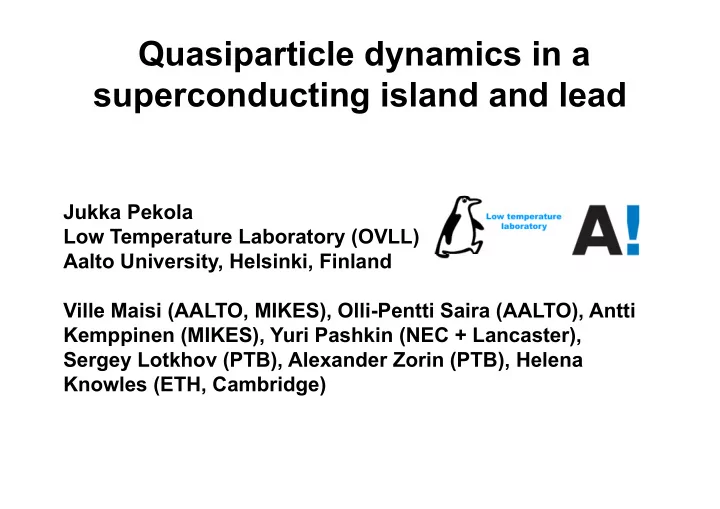

Quasiparticle dynamics in a superconducting island and lead Jukka Pekola Low Temperature Laboratory (OVLL) A lt Aalto University, Helsinki, Finland U i it H l i ki Fi l d Ville Maisi (AALTO MIKES) Olli-Pentti Saira (AALTO) Antti Ville Maisi (AALTO, MIKES), Olli-Pentti Saira (AALTO), Antti Kemppinen (MIKES), Yuri Pashkin (NEC + Lancaster), Sergey Lotkhov (PTB), Alexander Zorin (PTB), Helena g y ( ), ( ), Knowles (ETH, Cambridge)
Contents Contents 1. Motivation 2. Experimental techniques 3. Residual quasiparticles 4. Generated quasiparticles
Quasiparticle recombination p E ph = 2 ∆ Superconducting Recombination gap 2 ∆ with 2 ∆ phonon p emission Rothwarf and Taylor, 1967 K Kaplan et al, 1976 l t l 1976 Barends et al., 2008
Measurement of energy relaxation in a superconductor Measurement of energy relaxation in an Normal state aluminium bar, A. Timofeev et al, 2009 Superconducting (exp) Superconducting (theory)
Quasiparticle heat conduction in a superconductor Bardeen et al. 1958 Quasiparticle (heat) transport is exponentially suppressed at low temperatures in a Q i ti l (h t) t t i ti ll d t l t t i superconductor Measurement inc. inverse proximity effect, Peltonen et al., PRL 2010.
Typical quasiparticle numbers yp q p de Visser et al., PRL 2011.
Parity effect in superconducting SETs d ti SET I n electrons on the island Normal state, ∆ = 0 Superconducting Superconducting state , ∆ > E C M. Tuominen et al. (1992)
Single-electron turnstile with NIS- junctions junctions V Nature Physics 4, y , 120 (2008) time One electron is transferred through the turnstile in each gate cycle: I = ef. V g ∆ ∆ Superconducting gap J.P. et al., Nat. Physics 4 , 120 (2008) blocks single-electron tunneling at low energies
Hybrid single-electron turnstile I = Nef
Errors in pumping p p g Thermal errors Photon-assisted tunneling (coupling to environment) Multi-electron processes (co-tunneling, Andreev tunneling etc.) Residual and generated quasiparticles in a superconductor superconductor
Thermal error rates Optimum operation point of the turnstile is at eV = ∆ , where the error rate is At 100 mK for aluminium ( k B T N / ∆ = 0.04), this error is << 10 -8 << 10 8 . Yet the errors in the Yet the errors in the first experiments were much higher.
Influence of em-environment on single- electron current in a NIS junction electron current in a NIS-junction PHOTON ABSORPTION ABSORPTION and TUNNELING ∆ eV ∆ with env PRL 105 , 026803 (2010)
Dynes Density of States Dynes 1978, 1984 y , 6 5 4 n S (E) 3 0.10 n 0.08 n S (0) = γ 0.06 2 0.04 0.02 1 0.00 -1.0 -0.5 0.0 0.5 1.0 0 -2.0 -1.5 -1.0 -0.5 0.0 0.5 1.0 1.5 2.0 E / ∆
Careful filtering and shielding Lossy coaxes with a feed- through Double-walled hermetic metallic hermetic metallic sample stage On-chip capacitance to shunt the shunt the junctions
Counting single-electrons O.-P. Saira et al., PRB 82, 155443 (2010) ELECTROMETER C g C S V SET BOX S S N N A V g 0 – 1 s counting random errors at charge degeneracy errors at charge degeneracy 1 – 3 s pumping electrons at 20 Hz frequency 3 – 4 s quiet in the two hold modes modes
Andreev 2e transitions also observed V. Maisi et al., PRL 106, 217003 (2011)
Counting single-electrons on a turnstile 0 0 5 1 1 5 2 2 5 3 3 5 4 4 5 5 1 sec The observed transition rate equals Γ 1e ( eV ds /2) + Γ 1e (- eV ds /2) Γ ( eV ds /2) Γ ( eV ds /2) The rates can be attributed to: The rates can be attributed to: 1. Residual density of quasiparticles in the superconductor n qp : qp 2. Dynes parameter (DOS in the gap) γ : Dynes parameter (DOS in the gap) γ : 2
How ideal is Al superconductor? T Two major conclusions: j l i 1. Residual quasiparticle density < 0.033 ( µ m) -3 : Typical qp number in the leads = 0 Typical qp number in the leads = 0 2. Sub-gap density of states < 2 X 10 -7 D ( E F ) O.-P. Saira et al., PRB 85, 012504 (2012).
Relaxation of generated quasiparticles (I) i ti l (I) SINIS structures with different S-lead geometries SINIS structures with different S-lead geometries H. Knowles et al., APL 100 , 262601 (2012). gate amplitude Note: injection and relaxation of qp’s has been traditionally studied close to T c , see e.g. A. Schmid and G. Schön, JLTP 20, 207 (1975).
Relaxation of generated quasiparticles (II) i ti l (II) NISIN structure Black lines: V. Maisi et al., in preparation. N S N gate amplitude gate amplitude Black lines: qp pair relaxation τ -1 = 8 kHz
Summary Quasiparticles can be controlled and modelled - record-low quasiparticle densities [0.03 ( µ m) -3 ] achieved by filtering and qp trapping achieved by filtering and qp trapping - residual qp number can be suppressed to <<1 in ”practical” conductors - injected quasiparticles pose a difficult problem - injected quasiparticles pose a difficult problem and need care With proper qp control SINIS turnstile may eventually qualify for quantum metrology
Recommend
More recommend